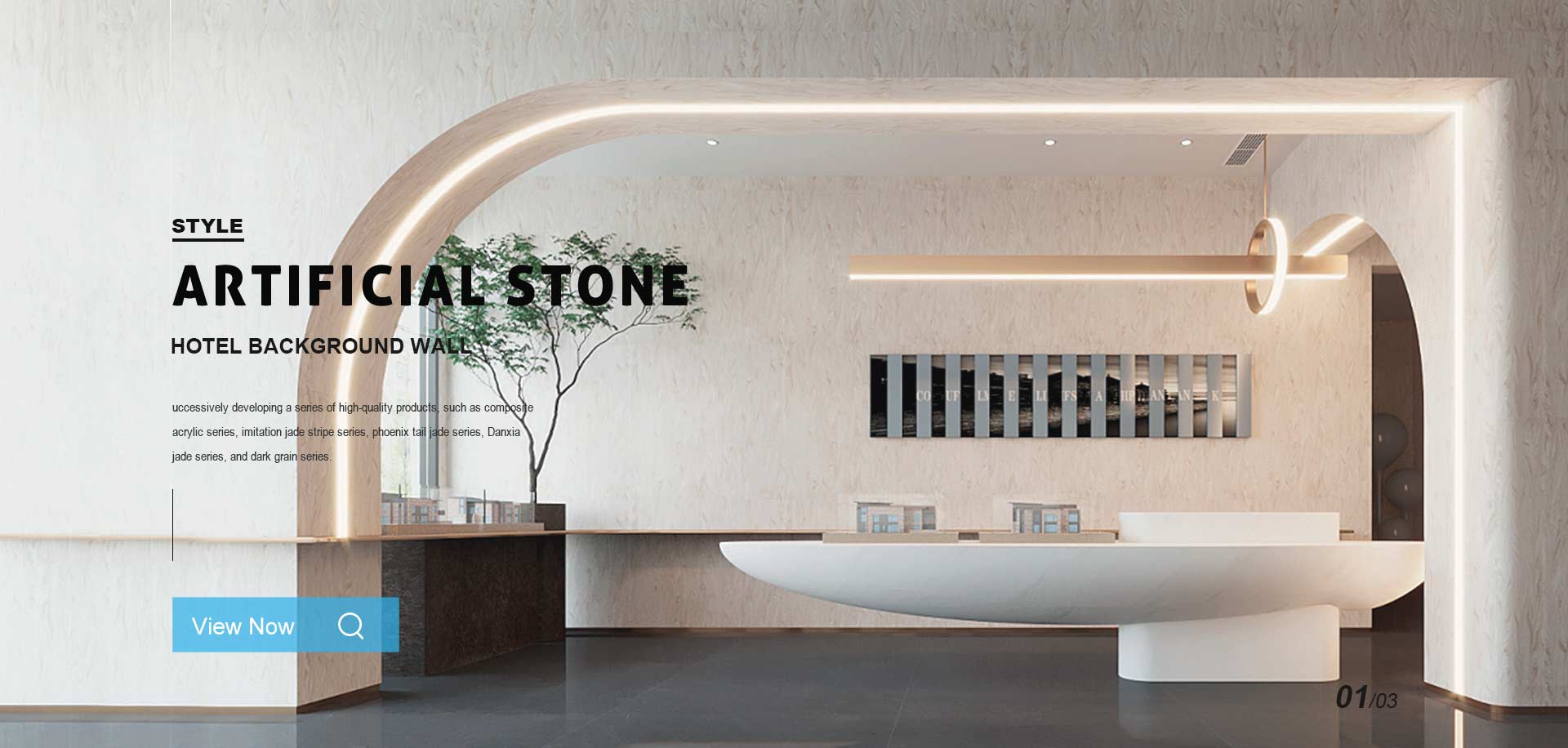

Solid Surface is a synthetic material made primarily from a mixture of acrylic resin (or other resins) and mineral fillers ( such as bauxite, talc, and so on). Through a special process, a Solid Surface material with uniform color and texture is formed. It can be processed into a variety of shapes and sizes and is suitable for a wide range of surface decoration needs.

Product Features
1. Seamless Splicing:Solid Surface can be seamlessly spliced together, with seams not easily visible at the splices, providing a smooth and beautiful surface.
2. Highly malleable:The material can be bent and molded with heat to accommodate a variety of design needs, including complex curves and shapes.
3. Durability:Solid Surface has excellent abrasion, scratch and chemical resistance, making it suitable for areas of high usage.
4. Easy Maintenance:The surface is smooth and does not easily accumulate dirt and bacteria. Cleaning and maintenance is simple and requires only wiping with warm water and a mild detergent.
5. Repairability:If the surface is scratched or damaged, it can be sanded and repaired to restore its original appearance without replacing the entire surface.
6. Variety of colors and textures:A wide selection of colors, textures and patterns are available to match a variety of design styles.
Application Areas
1. Kitchen Countertops:Widely used in kitchen countertops, providing a durable and easy to clean workspace.
2. Bathroom countertops and walls:Used for bathroom countertops and walls, waterproof, anti-mold, keep clean and sanitary.
3. Commercial space:such as front desk, desktop and wall decoration in hotels, restaurants and offices, to enhance the visual effect and functionality of the space.
4. Medical and laboratory environments:Suitable for medical and laboratory surface materials due to its antimicrobial and easy-to-clean properties.
5. Furniture manufacturing:Used to make surfaces for customized furniture, such as dining tables, desks and counters, to increase the aesthetics and practicality of the furniture.
Selection and Installation
Consider the following factors when selecting the right Solid Surface:
1. Color and Texture:Choose the right color and texture to match the overall decorative style according to the design requirements of the project.
2. Size and Specification:Select the appropriate size and specification according to the installation area and design requirements to ensure the suitability and effectiveness of the material.
3. Processing requirements:Consider the type of processing required, such as cutting, bending, etc., to ensure that the material can meet the design and construction requirements.
4. Installation method:Specialized adhesives are usually used for installation to ensure seamless splicing and material stability.
Maintenance and care
1. Regular cleaning:Use mild detergent and damp cloth to wipe the surface regularly, avoid using strong acidic or alkaline detergent to prevent damage to the material.
2. Avoid High Temperature:Avoid placing hot objects directly on the surface to prevent heat damage.
3. Repair scratches:Sand and repair minor scratches on the surface to maintain the appearance and function of the material.
4. Regular Inspection:Regularly inspect the condition of the material to ensure that there is no damage or looseness and that maintenance or repair is carried out in a timely manner.
FAQ:
What is Solid Surface?
Solid Surface is a solid surface material made from a mixture of synthetic resins and mineral fillers (e.g. bauxite, talc, etc.) with uniform color and texture, widely used in architecture and interior decoration.
What are the key features of Solid Surface?
Key features include seamless splicing, high plasticity, durability, ease of maintenance, repairability, and a wide variety of color and texture options.
What applications is Solid Surface commonly used for?
Solid Surface is commonly used in kitchen countertops, bathroom countertops and wall coverings, commercial space décor, medical and laboratory environments, and furniture manufacturing.
How does Solid Surface allow for seamless splicing?
Multiple panels are seamlessly spliced together using specialized adhesives and thermal processing techniques, resulting in smooth, seamless seams.
How durable is Solid Surface?
The material has good abrasion, scratch, and chemical resistance, making it suitable for high use areas.
How can I repair scratches or damage on Solid Surface?
Minor scratches or damage can be repaired by sanding and buffing to restore the original appearance and performance of the material.
What are the maintenance requirements for Solid Surface?
Regular cleaning of the surface, avoiding the use of strong acidic or alkaline cleaners, preventing damage from high temperatures, and regular maintenance by checking the condition of the material.
What are the machinability properties of Solid Surface?
The material has excellent machinability and can be cut, bent, engraved and drilled to suit a variety of design needs.
How do I select the right Solid Surface material?
Selection requires consideration of color and texture, size and gauge, processing requirements, and installation methods to ensure material suitability and effectiveness.
How environmentally friendly is Solid Surface?
Many man-made Solid Surface materials are produced using environmentally friendly materials and manufacturing processes that have a low environmental impact and are relatively sustainable.